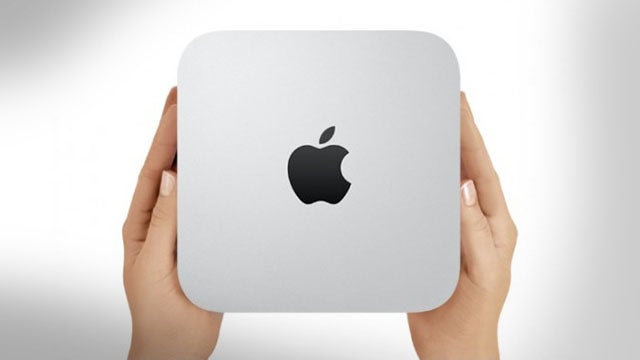Apple is breaking my heart with the Mac mini

Opinion: On Valentine’s Day, Computing Editor Michael Passingham ponders the merits of Apple’s most unloved device, the Mac mini.
One of the benefits of working for a big company is that you get a say in the type of computer you wish to use. I use a Lenovo ThinkPad, while many of my colleagues use MacBook Airs – a decision that requires an opinion piece of its own to understand.
Some folk choose Mac minis. They’ll take their Mac mini out of their locker and carry it to their ‘hot desk’ for the day. At the end of each day, they’ll unplug it and return it to their locker.
I know, it’s mind-boggling – and in more ways than you might think.
Related: Mac mini
For one, it has been 854 days since Apple’s last Mac mini update, or more than two years. In and of itself, the Mac mini’s age isn’t a problem, as you should generally be able to get at least three years out of a decent computer, and often many more.
But what you won’t see on any Apple spec sheet is the fact that its ‘latest’ Mac minis use Intel’s 4th-generation ‘Haswell’ Core processors.
These actually launched in July 2014, making the technology at the heart of the device positively ancient, at least in computer chip time.
These processors are significantly less efficient and powerful than current-gen Intel CPUs, and even pale in comparison to the 5th-gen kit found in the seemingly abandoned MacBook Air.
Compared to the 6th- and 7th-gen kit found in the latest 13-inch MacBook Pro? Don’t get me started.
Related: Intel Core i processors explained
At £479, the Mac mini is the cheapest way to join the excellent macOS ecosystem; even the most expensive Mac mini model ‘only’ costs £949, which is less than you’ll pay for a new MacBook Pro.
Yet given its fossilised internals, you won’t be making the most of what macOS Sierra has to offer.
You don’t get the benefits of a great touchpad, brilliant screen or backlit keyboard. You don’t get processors powerful enough to do multimedia tasks particularly well, and the cheapest model also comes with just 4GB of RAM, plus you have to attach numerous cables to get the benefit of its desktop form factor.
One argument in favour of the device is that it features more ports than all the MacBooks. This is true: it does have a pair of ThunderBolt/DisplayPort connectors and an HDMI port, along with four USB ports and an SD card slot.
However, it can’t output to a 4K monitor at more than a juddery 30Hz, making its high-res capability useless for many people. It’s lumped with slow hard disks in all but the most expensive model, which receives a slightly faster “Fusion” drive with a bit of solid state cache. But there’s no high-performance storage anywhere to be seen.
What really irks me here is that the Mac mini has the potential to be a fantastic machine.
Nowadays, you can quite happily squeeze a proper quad-core Intel processor into a compact PC chassis, rather than the piddly U-series dual cores in the Mac mini.
Intel’s Skull Canyon range of PCs, the stylish HP Pavilion Wave and the impressive Zotac Zbox Magnus, are but three examples of what can be achieved in a compact space.
To dive a bit deeper, let’s use the Pavilion Wave as our example. It’s a complete PC that includes a built-in speaker, high-quality design, and components that are substantially faster than the Mac mini.
Yet it costs, at most, £730 for 128GB of SSD storage, a 1TB hard disk and a proper quad-core i5 processor from Intel’s sixth-gen range. Plus, it can output 4K at a full 60Hz.
All this value from HP, a company that’s aggressively pursuing Apple levels of flashy lifestyle kit. Against the odds, it’s actually succeeding. Windows 10 may lag behind macOS in terms of ease of use, but HP’s PC shows what’s possible in hardware terms.
If Apple simply refreshed the Mac mini this year with the latest 7th-gen Intel Core processors, I might see a reason to buy one again. But what the mini really needs is a complete overhaul – a new design and components that match what consumers expect in 2017.
Oh, and a nice marketing push from Apple to help me feel better about parting with my hard earned cash.
Maybe a 2017 Mac mini update is in the works and being kept remarkably well under wraps. Given that so many people prefer macOS and the Apple brand – and that the Mac mini is, in terms of computers, the easiest way to get on board with these things – it would make sense.
Yet given the complete lack of rumours surrounding a Mac mini refresh, I fear for the future of this compact machine.
It’s a shame because, ultimately, it means that Apple is content with giving you a half-arsed user experience, undermining its great software by continuing to flog slow and outdated hardware.
That’s why, this Valentine’s Day, I’ve fallen out of love with Apple.
Come autumn, I hope Apple helps me open my heart again.
WATCH: Laptop buying guide
Do you agree with Michael? Share your thoughts in the comments below.


